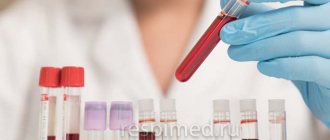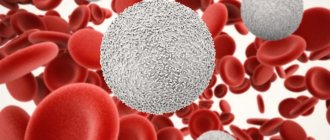Low Protein C Levels
An indicator shifted downward indicates the risk of blood clots during operations. There are many reasons why the indicator decreased, and they can be very serious:
- development of liver pathologies (hepatitis, liver failure);
- purulent processes in the body;
- infectious diseases (sepsis);
- oncology;
- AIDS;
- vitamin K deficiency;
- taking hormonal drugs;
- disseminated intravascular coagulation syndrome;
- blood clot formation.
Low levels may occur while taking anticoagulants (blood thinning medications). This should be taken into account by the attending physician when calculating the dose of the drug.
There is also a genetic (congenital) deficiency of fibrinolytic. In this case, monitoring should be carried out regularly, and the patient should be prescribed anticoagulant treatment.
Protein C
A study aimed at determining protein C in the blood to diagnose possible causes of thrombosis and thrombotic complications.
Synonyms Russian
Protein C; PS; coagulation protein C.
English synonyms
Protein C; PC; coagulation protein C.
Research method
Kinetic colorimetric method.
What biomaterial can be used for research?
Venous blood.
How to properly prepare for research?
- Eliminate fatty foods from your diet for 24 hours before the test.
- Avoid physical and emotional stress for 30 minutes before the test.
- Do not smoke for 30 minutes before the test.
General information about the study
Protein C is one of the most important proteins - factors of the anticoagulant (anti-coagulation) system of the blood. The synthesis of this protein occurs in the liver and is vitamin K dependent. Protein C is in constant circulation in the blood in an inactive state. Its activation occurs when a complex of thrombin and thrombomodulin acts on the surface of intact endothelial cells and platelets. In its active form, protein C partially destroys and inactivates non-enzymatic coagulation factors Va and VIIIa. The enzymatic action of protein C occurs in the presence of its cofactor, protein S. It is a vitamin K-dependent non-enzymatic cofactor synthesized in the liver and circulating in the bloodstream. As a result of the described interactions, blood coagulation processes are inhibited, and the processes of the anticoagulation system (fibrinolysis) are also indirectly activated.
Determining the concentration or activity of protein C in the blood is important in the diagnosis of various pathological conditions and diseases. A decrease in these indicators may be associated with a violation of the synthesis of protein C, its rapid consumption, or a violation of the protein structure and its functional inferiority. Protein C synthesis can be reduced as a result of congenital deficiency, vitamin K deficiency, liver pathologies, disruption of its synthetic function, during the neonatal period and in the elderly. Excessive protein consumption can be observed in thrombosis, thromboembolism, consumption coagulopathies, disseminated intravascular coagulation syndrome (DIC), after major operations and injuries. Impairment of the functional activity of protein C can be observed when taking anticoagulant drugs, in particular when taking oral warfarin. An increase in the concentration of protein C can be observed during pregnancy, when taking estrogen-based oral contraceptives, and with kidney disease.
Congenital protein C deficiency occurs in 0.2-0.5% of cases and is characterized by a severe course. It requires preventive and therapeutic measures to prevent the development of thrombosis and fatal complications. A rare variant of homozygous protein C deficiency manifests itself as fulminant DIC syndrome in newborns and requires urgent diagnostic measures and treatment.
In pregnant women, protein C deficiency leads to a number of severe pathological processes and complications. Thrombosis and thromboemoliia may develop with damage to the deep veins of the lower extremities, pelvic organs, and cerebral vessels, and a possible complication in the form of pulmonary embolism. Intrauterine growth retardation as a result of fetoplacental insufficiency, spontaneous abortions and repeated miscarriages may occur. The risk of developing preeclampsia, eclampsia and disseminated intravascular coagulation increases.
When taking indirect anticoagulants and with a significant decrease in protein C activity to or less than 50% of the norm, skin necrosis may develop. Such “warfarin necrosis” develops rarely, but is characterized by a severe course and requires careful medical supervision. Therefore, it is recommended to carry out treatment with indirect anticoagulants under the control of protein C activity. Control and repeated determinations of protein C should be carried out at least a month after discontinuation of the drugs.
The main manifestations of protein C deficiency are arterial and venous thrombosis of various locations. Myocardial infarction, stroke, and pulmonary embolism may occur in the absence of other predisposing factors and in young people. Determination of the concentration/activity of protein C can also be recommended for oncological diseases, purulent-inflammatory diseases, sepsis and septic processes.
What is the research used for?
- To diagnose the concentration or activity of protein C;
- To diagnose the concentration or activity of protein C when identifying the causes of thrombophilias and thrombotic complications;
- To identify possible causes of arterial and venous thrombosis of various locations, in particular in young people;
- To diagnose the causes of thrombotic complications during pregnancy;
- To diagnose possible causes of the development of thrombotic complications in newborns, in the complex diagnosis of congenital protein C deficiency;
- For the diagnosis of protein C during treatment with indirect anticoagulants, warfarin;
- For the diagnosis of protein C in oncological, purulent-inflammatory diseases, sepsis.
When is the study scheduled?
- With a comprehensive examination to identify the causes of thrombosis (determination of antithrombin III, protein S, etc.);
- For clinical manifestations of arterial and venous thrombosis: myocardial infarction, stroke, pulmonary embolism, deep vein thrombosis of the lower extremities, pelvic organs, etc.;
- For symptoms of congenital thrombosis, presumably associated with protein C deficiency;
- For pregnancy pathologies: preeclampsia, eclampsia, disseminated intravascular coagulation syndrome, intrauterine growth retardation, spontaneous abortions, repeated miscarriages;
- When treated with indirect anticoagulants, warfarin; with the development of warfarin skin necrosis;
- With vitamin K deficiency, liver pathologies;
- For oncological, purulent-inflammatory diseases, sepsis.
What do the results mean?
Reference values: 70 - 140%.
Reasons for increased protein C levels:
- Pregnancy;
- Taking estrogen drugs;
- Kidney diseases.
Reasons for low protein C levels:
- Congenital protein C deficiency;
- Vitamin K deficiency;
- Liver pathologies;
- Thrombosis, thromboembolism;
- Disseminated intravascular coagulation syndrome (DIC syndrome);
- Extensive surgical operations, injuries;
- Taking anticoagulant drugs, in particular warfarin;
- Purulent-inflammatory diseases;
- Sepsis;
- Oncological diseases.
What can influence the result?
Taking indirect anticoagulant drugs, warfarin.
Important Notes
- Determining the level of protein C is recommended to be carried out along with comprehensive laboratory diagnostics of other indicators of the coagulation and anti-coagulation systems of the blood.
- It is recommended to carry out treatment with indirect anticoagulants under the control of protein C activity. Control and repeated determinations of protein C must be carried out at least a month after discontinuation of the drugs.
Also recommended
- Protein S free
- Antithrombin III
- Lupus anticoagulant
- Coagulogram No. 1 (prothrombin (according to Quick), INR)
- Thrombin time
- Coagulogram No. 2 (prothrombin (according to Quick), INR, fibrinogen)
- Coagulogram No. 3 (prothrombin (according to Quick), INR, fibrinogen, ATIII, APTT, D-dimer)
- Annexin V IgG antibodies
Who orders the study?
Therapist, general practitioner, hematologist, gynecologist, neonatologist, pediatrician, obstetrician-gynecologist, surgeon, anesthesiologist-resuscitator.
Literature
- Dolgov V.V., Menshikov V.V. Clinical laboratory diagnostics: national guidelines. – T. I. – M.: GEOTAR-Media, 2012. – 928 p.
- Fauci, Braunwald, Kasper, Hauser, Longo, Jameson, Loscalzo Harrison's principles of internal medicine, 17th edition, 2009.
- Christiaans SC, Wagener BM, Esmon CT, Pittet JF. Protein C and acute inflammation: a clinical and biological perspective / Am J Physiol Lung Cell Mol Physiol. 2013 Oct 1;305(7):L455-66.
- Bouwens EA1, Stavenuiter F, Mosnier LO. Mechanisms of anticoagulant and cytoprotective actions of the protein C pathway / J Thromb Haemost. 2013 Jun;11 Suppl 1:242-53.
Table of norms by trimester
| Dates of pregnancy | Indicator as a percentage |
| First trimester | from 78 to 121 |
| Second trimester | from 83 to 133 |
| Third trimester | from 67 to 135 |
What are the dangers of low protein C in the blood of a pregnant woman? The development of deep vein thrombosis in the legs is a fairly common occurrence for pregnant women. A decrease in protein increases the risk of developing blood clots by 10 times.
A deficiency of cells can cause a serious condition in newborns called purpura fulminans, which is the formation of clots that block small blood vessels. This disease often ends in death. This is why regular monitoring during pregnancy is so important.
C-reactive protein (CRP)
C-reactive protein (CRP) is the most important acute-phase response reagent from a pathogenetic and diagnostic point of view. This protein was discovered in 1930 by W. Tillet and T. Francis, who discovered that a protein appears in the serum of patients with acute infectious diseases that can bind to C-polysaccharides (Ca2+-binding) of the pneumococcal cell wall.
Typically, CRP appears in the blood much earlier than the appearance of antibodies. Along with 40 other proteins, it belongs to the so-called group of “acute phase” proteins. They include proteins of the blood coagulation system, complement factors, antiproteases, transport proteins and are important components of the body's first nonspecific line of defense
The synthesis of CRP occurs mainly in the liver - mainly by hepatocytes and, more moderately, can be synthesized by neurons, kidney cells, monocytes, lymphocytes and macrophages of the alveoli, and CRP is also synthesized by macrophages and smooth muscle cells located in atherosclerotic plaques. In small quantities, CRP can be secreted by activated normal killer cells, some subpopulations of mature T lymphocytes, as well as certain types of neurons under physiological conditions.
The main organs that remove CRP from the bloodstream are the kidneys and liver. In addition, during extensive inflammatory processes, significant uptake of CRP by “inflammatory” macrophages and neutrophils occurs, as well as its extracellular destruction by proteinases at the site of inflammation. It is known that the half-life of CRP from the bloodstream is normally 18-20 hours, while during extensive inflammatory processes it can decrease by 1.5-2 times.
The average values of CRP levels range from 0.5-1.5 mg/l, without specific gender differences, the presence of physiological pregnancy, but with a tendency to increase in older people. An increase in blood CRP ≥10 mg/l as a criterion of systemic inflammation in the body can be observed in many diseases such as: severe purulent-inflammatory infections, acute malaria, parasitic infestations, systemic forms of mycoses, necrosis, extensive surgical interventions and injuries, burns III and IV degree or extensive frostbite, chronic renal failure, preeclampsia, lymphogranulomatosis, many autoimmune diseases, metastatic malignant tumors, delocalized vasculitis of any origin. An increase in the level of CRP in the blood begins 6-12 hours after the manifestation of a pronounced inflammatory process and can double every 8 hours, and in case of sepsis in 1-2 days it can increase from trace amounts to 1-2 g/l. Moreover, the level of CRP, as a rule, directly correlates with the severity of tissue damage and the inflammatory response. A CRP concentration of up to 20 mg/l, determined 6-12 hours after the onset of the manifestation of an acute infectious disease, allows one to exclude a bacterial infection in favor of a viral one.
It is important to note that CRP, although sensitive, is a very nonspecific indicator of systemic inflammation, and its level increases under various conditions: increased physical activity, low physical activity, sleep disorders, chronic fatigue, high or low alcohol consumption, depression, oral contraceptives, hormone replacement therapy, cancer, etc. It has been noted that weight loss and increased physical activity lead to a decrease in the concentration of CRP.
Of all the acute phase proteins, CRP increases its concentration faster than other proteins and remains in this state longer than others. It is this property that has made SRB popular in diagnostics. Currently, there are two methods for determining CRP: low- and high-sensitivity. For the first method, the lower limit of normal is 10 mg/l. For the highly sensitive method, 10 mg/l is its upper limit, and the lower limit is 0.5 mg/l. There are various methods for determining high sensitive CRP (high sensitive - hsCRP): ELISA, FIA, turbidimetry, latexagglutination, immunodiffusion. The highly sensitive test is based on latex-enhanced immunoturbodimetry. This test is of independent importance for clinical practice due to the following properties: the concentration of CRP is quite stable due to the relatively long half-life; the determination method is standardized, WHO-certified standards and control materials are available; the results of determining CRP in fresh, stored and frozen plasma are practically the same; the determination method is simple and applicable when monitoring patients on an outpatient basis.
The concept of “thrombophilia” unites all hereditary and acquired disorders of hemostasis, in which there is a predisposition to the early manifestation and recurrence of thrombosis, thromboembolism, ischemia and infarction of organs [2]. For practical purposes, it is very important to distinguish congenital thrombophilia, since we are talking about thrombogenic factors that accompany patients throughout their lives. Congenital thrombophilia is a tendency to thrombosis due to congenital predisposing factors [13], regardless of the cause. For many years, antiphospholipid syndrome (APS) was classified as an acquired form of thrombophilia, but now there is evidence of the genetic nature of the origin of APS [5], which, however, does not prevent this condition from still being classified as thrombophilia. In patients with thrombophilia, thrombotic complications occur in situations where other people do not experience such complications: when oral contraceptives are prescribed, during pregnancy, during uncomplicated surgical operations, during long trips and in an uncomfortable position, etc.
Patients with thrombophilia are characterized by the occurrence of heart attacks and strokes at a young age - up to 50 years - without obvious predisposing factors, as well as thrombosis of unusual locations: retinal vessels, brain, veins of the upper half of the body, superficial epigastric, pudendal veins, ileofemoral thrombosis. Obstetric losses are characterized by early miscarriages, late miscarriages, repeated undeveloped pregnancies, the occurrence of severe forms of late gestosis with termination of pregnancy before 34 weeks, the development of fetal growth restriction syndrome, sudden fetal death syndrome, and premature abruption of a normally located placenta.
Clinical manifestations of thrombophilia are thrombotic complications or obstetric losses, as there are relevant publications in the medical literature [1, 3, 11]. This distinguishes thrombophilia from simple polymorphism of genes, the number of different combinations of which exceeds 1.5 million. Therefore, polymorphism of the genes fibrinogen, factor VIII (FVIII), factor XIII (FXIII), etc. should be considered simple polymorphism of genes, since to date they have not been proven connection with clinical pathology.
Congenital thrombophilias include the following conditions:
- deficiency of anticoagulant proteins: antithrombin III (AT III) below 70% (by activity), protein C (PS) below 65%, protein S (PS) below 55%;
- polymorphism of FV Leiden genes - homo- (A/A) or heterozygous carriage (A/G);
— polymorphism of the prothrombin gene FII G20210A — homo- (A/A) or heterozygous carriage (A/G);
- polymorphism of the methylenetetrahydrofolate reductase (MTHFR) gene C677T - homo- (T/T) or heterozygous carriage (C/T);
- polymorphism of the plasminogen activator inhibitor gene type I (plasminogen activator inhibitor - PAI-I) - homo- (4G/4G) or heterozygous carriage (4G/5G);
— antiphospholipid syndrome (APS), diagnosed according to modern diagnostic criteria in 2006 [10];
- hyperhomocysteinemia - homocysteine content in fasting blood plasma more than 15 mmol/l.
APS can be diagnosed if 1 clinical and 1 laboratory criteria are met. Clinical criteria:
1. Arterial or venous thrombosis without inflammation of the vascular wall.
2. Pathology of pregnancy:
a) one fetal death after 10 weeks of pregnancy or more;
b) eclampsia, gestosis or placental insufficiency in less than 34 weeks of pregnancy;
c) 3 spontaneous abortions or more in less than 10 weeks of pregnancy without anatomical, hormonal, or chromosomal disorders.
Laboratory criteria:
1. Twice positive test for lupus anticoagulant with an interval of 12 weeks;
2. Anticardiolipin antibodies in high titers (more than 40 units), determined by ELISA with an interval of 12 weeks;
3. Presence of antibodies to β-2-glycoprotein-I.
It should be remembered that APS should not be diagnosed in cases where the time interval between clinical and laboratory manifestations is less than 12 weeks and more than 5 years, and superficial venous thrombosis is not included in the criteria for diagnosing APS.
Indications for examination of patients
Examination is prescribed for patients in the event of idiopathic thrombosis, stroke, heart attack, miscarriage, severe gestosis, premature abruption of a normally located placenta, premature birth before 34 weeks of gestation, a history of fetal growth restriction syndrome, thrombosis while taking oral contraceptives or hormone replacement therapy (HRT). Based on the 3-year experience of the Moscow Regional Research Institute of Obstetrics and Gynecology (570 pregnant women with thrombophilia, mainly caused by a combination of heterozygous carriage of the MTHFR and PAI-I genes, were observed), we consider it advisable to screen for thrombophilia in the complicated course of this pregnancy, even in the absence of obstetric complications history, which allows justifying treatment with anticoagulants and preventing the progression of complications.
Normal conditions are considered to be ATIII activity of 70% and above, protein C - 65% and above, protein S - 55% and above; FV Leiden - G/G, prothrombin FII G20210A - G/G, MTHFR C677T - C/C, PAI-I - 5G/5G, homocysteine content in fasting blood plasma below 15 mmol/l.
It is also likely that thrombophilias should include polymorphism of the angiotensin converting enzyme gene (ACE I/D) and polymorphism of the endothelial receptor of protein C (ERPC), respectively associated with relapses of severe gestosis and repeated miscarriages in early pregnancy. .
Diagnosis of thrombophilias
For patients at risk - if there is a history of idiopathic or pregnancy-related thrombosis, or with the use of oral contraceptives, heart attacks, strokes, obstetric losses, severe gestosis, a history of abruption of a normally located placenta, failures when trying in vitro fertilization and embryo transfer - prescribed examination. It is advisable to obtain information as early as possible in order to make a decision on treatment: during prenatal examination, examination in the first trimester of pregnancy, if a complication occurs during this pregnancy.
Testing for thrombophilia includes:
— determination of the percentage of activity of anticoagulant proteins: AT III, PS, PS;
— study of gene polymorphism: FV Leiden, FIIG20210A, MTGFRS677T, PAI-I;
— determination of homocysteine content on an empty stomach;
- study of lupus anticoagulant, antibodies to cardiolipins and antibodies to β2-glycoprotein I.
Blood sampling for genetic studies and determination of homocysteine is carried out in a test tube with ethylenediamineacetic acid; for the determination of lupus anticoagulant, antibodies to cardiolipins and β2-glycoprotein-I in a citrate tube (for example, Monovet-S). When using heparin, test results may be distorted. If one thrombophilia factor is identified, the following diagnosis is made, for example: thrombophilia - heterozygous carriage of FIIG20210A A/G; if several thrombophilia factors are identified, a diagnosis of combined thrombophilia is made with a list of defective factors, for example: combined thrombophilia - heterozygous carriage of FV Leiden A/G, homozygous carriage of PAI-I 4G/4G, hyperhomocysteinemia.
Treatment of pregnant women with thrombophilias
Treatment with anticoagulants in patients with a deficiency of proteins—anticoagulants: antithrombin-III, protein C, protein S—reduced the risk of fetal loss [6].
Patients should be divided into two groups:
- having a history of obstetric losses;
- with a history of thrombotic complications and during current pregnancy.
Treatment is possible with both unfractionated heparin (UFH) and low molecular weight heparins (LMWH): fragmin, fraxiparin, clexane. UFH, compared to LMWH, have a more pronounced anticoagulant effect, inactivating active molecules of blood coagulation factors: II, X, IX, XI, XII, reducing the number of microvesicles, increasing the content of tissue factor inhibitor, activating fibrinolytic activity, and inhibiting complement system factors [7]. Treatment with UFH is possible in the form of subcutaneous injections or inhalations through an ultrasonic inhaler. LMWH drugs have their own pharmacokinetics and are not interchangeable. Treatment is carried out in a prophylactic dosage - for UFH 10,000 or 15,000 units subcutaneously and, as a rule, does not require laboratory monitoring.
If there is a history of obstetric losses, treatment begins in the early stages of gestation to ensure adequate placentation from 4-5 weeks to 34 weeks of pregnancy, usually subcutaneous UFH 5000 units 2 times a day with an interval of 12 hours. To exclude heparin-induced thrombocytopenia at 4, 8 and On the 15th day of treatment with UFH, the platelet count should be determined in a clinical blood test. After 34 weeks of gestation, natural involutive changes occur in the placenta, and the use of heparin does not improve pregnancy outcome, theoretically increasing the risk of hemorrhagic complications. In the form of inhalations, heparin is used in a dosage of 500-700 units/kg every 12 hours. If the patient is large (more than 90 kg), heparin can be used in the same dose every 8 hours.
If there are thrombotic complications in a patient with thrombophilia during current pregnancy and a history of treatment after treatment by vascular surgeons, UFH therapy is administered at 5000 units every 12 or 8 hours without laboratory control. Due to the increase in the number of thrombotic complications in pregnant women in the third trimester and in the postpartum period, especially in the first 4 weeks, it is advisable to prescribe a regimen of 5000 units 3 times a day. The use of UFH in a daily dose of up to 20,000 units does not require laboratory control. Delivery, surgery and puncture of the epidural space are safe if the thrombin and activated partial thromboplastin time are normal and the patient’s platelet count is normal [12].
If clinical and laboratory examination does not make it possible to diagnose APS, but there is a constantly high titer of anticardiolipin antibodies, antibodies to anti β2-glycoprotein I, a positive lupus anticoagulant is constantly determined, treatment with UFH is indicated in a prophylactic dose - 5000 units subcutaneously with an interval of 12 hours.
When treating pregnant women with LMWH, achieving prophylactic treatment levels (0.3-0.5 units of anti-Factor Xa activity) is difficult due to the increase in glomerular filtration rate and volume of distribution as pregnancy progresses, so the recommended level of anti-Factor Xa activity can be achieved only with individual dose selection for the patient [4, 8]. Often, treatment with LMWH does not prevent the development of fetal malnutrition, and the use of UFH is preferable.
Treatment of patients with thrombotic complications requires a minimal interruption in the use of drugs during delivery. When carrying out programmed labor and planned cesarean section, the last heparin injection is carried out the night before, before 15:00 the next day, delivery is carried out and 3 hours after birth, heparin therapy is resumed at 5000 units every 12 hours throughout the entire postpartum period. Prescription of a full therapeutic dose of heparin is possible one day after birth and is monitored by the level of activated partial thromboplastin time for UFH and the level of anti-Xa factor for LMWH. Since during normal pregnancy and its complications the D-dimer content is increased, this indicator cannot be used either for diagnostic purposes or to monitor the effectiveness of LMWH treatment [9].
During prophylactic treatment of patients with thrombophilia with heparin, as a rule, there is no need to prescribe other drugs that actively affect the blood coagulation system. The use of other medications is not contraindicated.
This practice of managing pregnant women with thrombophilia allows achieving a favorable pregnancy outcome.







